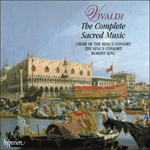Vivaldi wrote the Laudate Dominum, RV606, a concise but powerful single-movement setting of Psalm 116 (117 in Protestant bibles) for choir and strings, in his ‘first’ period at the Pietà. Having only two verses, plus the mandatory Lesser Doxology, the Psalm could hardly have been treated otherwise (it is the Psalms with around ten verses that make the best candidates for multi-movement treatment). Vivaldi concentrates melodic and rhythmic interest in the part for unison violins, treating the choir as a kind of ‘texted continuo’. This violin part is based on a short, arching motive that in some shape or form reappears once or twice in literally every bar. Half-way through, the composer produces a masterstroke, illustrating the word ‘misericordia’ (mercy) with a surging progression in sustained notes that takes the music momentarily into the distant region of B flat minor (the home key is D minor).
from notes by Michael Talbot © 2000
Vivaldi écrivit Laudate Dominum, RV606, une mise en musique du psaume 116 (117 dans les bibles protestantes), concise mais puissante, en un mouvement, pour chœur et cordes, au cours de sa «première» période à la Pietà. Avec seulement deux versets, plus l’obligatoire petite doxologie, ce psaume n’aurait guère pu être traité autrement (ce sont les psaumes d’une dizaine de versets qui se prêtent le mieux à un traitement en plusieurs mouvements). Vivaldi concentre la dynamique mélodico-rythmique dans la partie dévolue aux violons à l’unisson, traitant le chœur comme une manière de «continuo à texte». Cette partie violonistique repose sur un court motif en arche qui reparaît une ou deux fois, sous une forme ou sous une autre, dans pratiquement chaque mesure. À mi-œuvre, le compositeur réussit un coup de maître en illustrant le mot «misericordia» (miséricorde) par une progression déferlante en notes tenues, qui entraîne momentanément la musique dans la lointaine région de si bémol mineur (la tonalité principale étant ré mineur).
extrait des notes rédigées par Michael Talbot © 2000
Français: Hyperion Records Ltd
Vivaldi schrieb diese knappe, aber eindrucksvolle Vertonung des 116. Psalms Laudate Dominum (Nr. 117 in protestantischen Bibeln) für Chor und Streicher in einem Satz während seiner „ersten“ Zeit an der Pietà. Mit nur zwei Versen plus der obligatorischen Kleinen Doxologie konnte dieser Psalm kaum anders umgesetzt werden (es sind die Psalmen mit zehn oder mehr Versen, die sich am besten zur mehrsätzigen Umsetzung eignen). Vivaldi konzentriert das musikalische und rhythmische Interesse auf den Part der unisono geführten Geigen und behandelt den Chor als eine Art „Continuo mit Text“. Die Geigenstimme basiert auf einem kurzen bogenförmigen Motiv, daß in dieser oder jener Gestalt buchstäblich in jedem Takt ein- oder zweimal vorkommt. Mittendrin gelingt dem Komponisten ein Meisterstück—er veranschaulicht das Wort „misericordia“ (Barmherzigkeit) mit einer aufwallenden Fortschreitung ausgehaltener Töne, die die Musik vorübergehend ins entlegene b-Moll führt (die Grundtonart ist d-Moll).
aus dem Begleittext von Michael Talbot © 2000
Deutsch: Anne Steeb/Bernd Müller


 Vivaldi: The Complete Sacred Music
Vivaldi: The Complete Sacred Music
